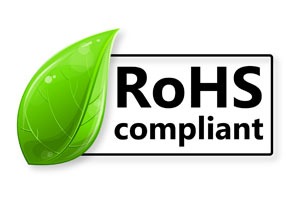
RoHS CERTIFICATE
RoHS Certificate (Restriction of Hazardous Substances) is a declaration demonstrating compliance with the European Union directive (2011/65/EU and subsequent amendments) that restricts the use of certain hazardous substances in electrical and electronic equipment (EEE). This document proves that the products are below the limit values for the substances specified in this directive or are covered by an exemption.
Purpose of the RoHS Directive:
Protecting Human Health: To minimize the harmful effects of hazardous substances in EEE on human health.
Protecting the Environment: To prevent the release of these substances into the environment and avoid difficulties in waste management.
Facilitating the Recycling of EEE: Restricting hazardous substances makes the recycling of EEE safer and more efficient.
Hazardous Substances Covered by RoHS and their Limit Values:
The RoHS Directive restricts the use of the following six hazardous substances and specifies maximum concentration values for each (as a percentage by weight in homogeneous materials):
Lead (Pb): 0.1%
Mercury (Hg): 0.1%
Cadmium (Cd): 0.01%
Hexavalent Chromium (Cr(VI)): 0.1%
Polybrominated Biphenyls (PBB): 0.1%
Polybrominated Diphenyl Ethers (PBDE): 0.1%
Four new phthalates were added with Directive 2015/863 and their limit values (RoHS 3):
Bis(2-ethylhexyl) phthalate (DEHP): 0.1%
Butyl benzyl phthalate (BBP): 0.1%
Dibutyl phthalate (DBP): 0.1%
Diisobutyl phthalate (DIBP): 0.1%
The restriction for these phthalates has been effective since July 22, 2019, and for medical devices and monitoring and control instruments, it came into effect on July 22, 2021.
Which Products are Covered by RoHS?
The RoHS Directive covers a wide range of electrical and electronic equipment. Some of these include:
Large household appliances
Small household appliances
IT and telecommunications equipment
Consumer equipment
Lighting equipment
Electrical and electronic tools
Toys, leisure, and sports equipment
Medical devices
Monitoring and control instruments
Automatic dispensers
Other electrical and electronic equipment not falling into other EEE categories


How to Obtain RoHS Compliance?
It is not necessary to obtain a separate "RoHS Certificate" to declare RoHS compliance. Manufacturers declare that their products comply with the RoHS Directive within the technical file and, upon request, provide supporting documents (test reports, material declarations, etc.) to demonstrate this compliance.
Steps to Ensure RoHS Compliance:
Supply Chain Management: Ensuring that components and materials procured from suppliers are RoHS compliant.
Material Analysis: Analyzing the materials used in the products for the hazardous substances specified in RoHS.
Design Changes: If necessary, making design changes to replace non-compliant materials with alternative materials.
Production Controls: Controlling the production process to ensure RoHS compliance.
Documentation: Keeping all documents proving the product's RoHS compliance (test reports, material declarations, technical file) complete and up-to-date.
Relationship Between RoHS and CE Marking:
RoHS compliance is one of the prerequisites for obtaining CE marking for many electrical and electronic equipment. Manufacturers must verify that their products comply with the RoHS Directive and document this in their technical file before affixing the CE marking.
Contact Us to Begin Your RoHS Certificate Process.
We offer affordable and effective solutions tailored to your needs.
The information presented on this website does not constitute legal advice and is intended for informational purposes only. KompassEurope.com.tr assumes no responsibility for any errors or omissions in the information contained on this website. Any decisions made or actions taken by the reader based on this information are solely at the reader's own risk, and KompassEurope.com.tr shall not be held liable for any legal consequences arising from such decisions or actions. Readers are strongly advised to seek professional legal counsel regarding their specific circumstances and concerns.
© 2025 Kompass Europe. All rights reserved. The contents of this website belong to Kompass Europe and are protected by copyright laws. Copying, publishing, distributing or any commercial use of the information on the website is possible only with written permission. By using this site, you agree to our Terms of Use and Privacy Policy.
